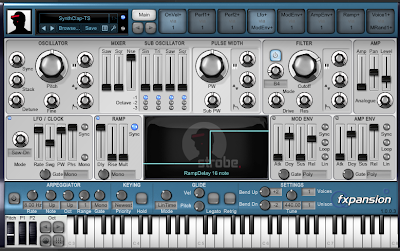
As far as programming drum sounds on a synthesizer goes, hand claps are probably second only to crash cymbals in their difficulty to synthesize convincingly. The truth is, you're not going to get anything akin to an 808 clap sound out of the vast majority of synths. However, with a little work, you can get the sorts of analog clap sounds you might hear on old Human League records. (And if you have never heard their albums "Reproduction
I messed around with a couple of softsynths for this type of sound and found FXpansion's Strobe gave the most satisfactory results to my ears. You should be able to follow along with just about any decent virtual analog, though.
1. Start with an INIT type preset. Strobe defaults to this, so if you're using it, you'll be ready to go. Hand claps, much like snares, are primarily noise based. So the first thing you'll want to do is to head over to the MIXER section and raise the NSE (noise) slider all the way up. We won't need any tone like you do with a snare sound, so we'll turn the SAW and SQR sliders all the way down. Make sure all the Strobe's SUB OSCILLATOR sliders are turned down all the way, too.
2. The first thing we're going to want to do is to program the amplitude envelope which shapes the volume contour of the sound. This is a percussive sound, so head over to the AMP ENV and set the ATK (attack) and SUS(tain) sliders all the way down to 0. Set your DCY (decay) slider to a fairly high value (I set mine to 2.05 seconds), and jack the REL (release) slider all the way up. We want the sound to play all the way through no matter how long we hold down a key.
3. Next, let's set up the filter. Make sure the FILTER is turned on (the little power switch in the upper left hand corner should be lit up). You can experiment with different filter types, but bandpass filters are generally best suited for this kind of sound. So change Strobe's FILTER MODE to B4 for a bandpass filter with a fairly steep cutoff. Speaking of which, set your CUTOFF value to a fairly high value (I chose +57.00). This already sounds better, but to give the sound a bit more of a 'crack', turn up the RES(onance) up a bit to around 39%.
4. You should have something akin to a synthy snare at this point, but it doesn't really sound very "clappy" yet. That's because when you have a group of people clapping their hands, the impact of each person's hands is not occurring at the exact same time. We can emulate this effect by using a downward ramp waveform on the LFO to modulate the sound's amplitude. The 4th modulation slot from the left in Strobe should already be set to LFO+ as a source, so go ahead an select it. Strobe has a cool modulation system that lets you modulate any number of parameters from a single source very easily. Go ahead and turn the AMP level down in the AMP section. You'll notice the slider is split into two parts. Drag the upper part to the top and you should see a yellow line in the slider window. This represents the range of modulation.
5. We're almost done! Head on over to the LFO section and set the MODE to SAW-DN. The SWG, PW, and PHS values can be used to further shape the LFO that is modulating our AMP level. Adjust this to taste. Also, make sure the SYNC button is turned off. Now we have something that sounds a little bit more like a bunch of hands clapping slightly out of time with one another. If your synth allows you to set a fade out value on your LFO, set this to a fairly short length so we're just getting that chaotic bit at the initial impact of the sound.
6. You should have something vaguely resembling a hand clap sound at this point, but to take it to that next level, try adding a little bit of short reverb to flesh things out a bit. If you've done everything correctly, you should have something that sounds vaguely like this:
And here's the patch for Strobe users.




















No comments:
Post a Comment